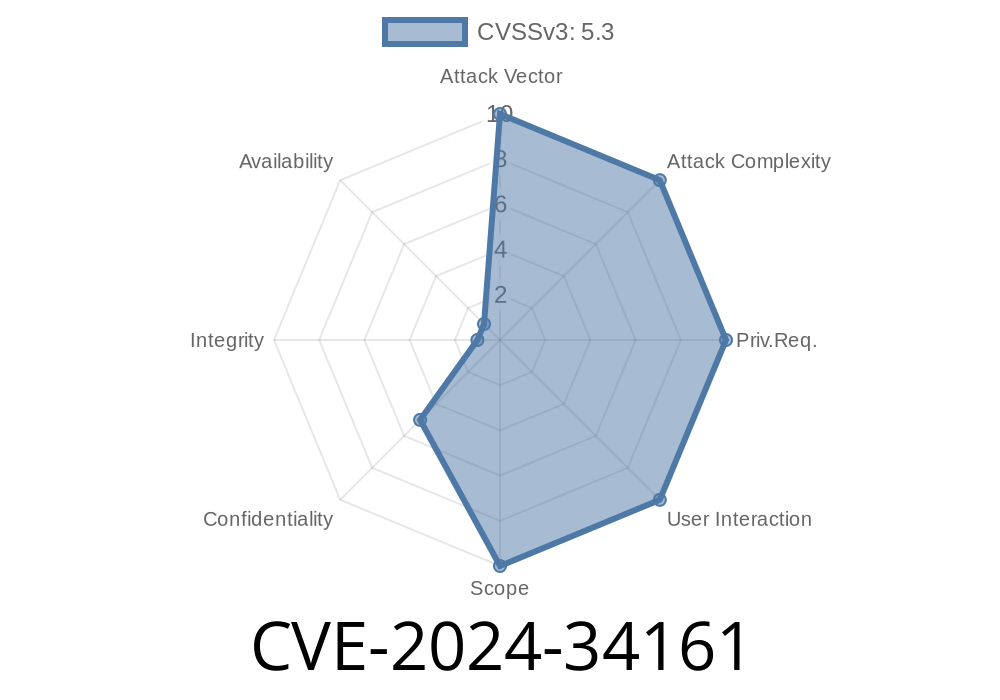Date: June 2024
Severity: High
Affected: NGINX Open Source and NGINX Plus with HTTP/3 QUIC enabled
Introduction
Security vulnerabilities in the foundations of the web can ripple out to affect millions of users. The recent CVE-2024-34161 is a great example — it targets the new HTTP/3 QUIC support in NGINX. If you have a large network setup and use NGINX for high-performance web delivery, this bug could put you and your users at risk. Let’s break down what’s going on, why it matters, and how you can stay safe.
What Is CVE-2024-34161?
NGINX has become one of the world's most popular web servers. With the introduction of HTTP/3 support (which uses the QUIC protocol), performance and security go up. But now, a memory leak was discovered:
- When NGINX (Open Source or Plus) uses the HTTP/3 QUIC module, specially crafted QUIC packets can make NGINX worker processes leak previously freed memory.
- The risk is higher if your network MTU is 4096 bytes or more, since no fragmentation occurs and big packets come all at once.
- Attackers can potentially use this to cause a Denial of Service (DoS), or even read sensitive memory from your web server.
Bottom Line: If you use NGINX with HTTP/3 QUIC on a large MTU network, you should patch ASAP.
Technical Details: How Does This Exploit Work?
At its core, the vulnerability is about how NGINX handles memory with large, undisclosed QUIC packets.
- MTU (Maximum Transmission Unit): If your infrastructure allows packets of 4096 bytes or bigger (very common in cloud and high-speed networks), then large QUIC packets come through without being split up.
- QUIC Module's Flaw: The HTTP/3 QUIC module in NGINX doesn't safely handle these big packets. When processing malformed or specially crafted packets, NGINX might access memory that was already freed.
- Memory Leak: This allows small chunks of memory that NGINX has already returned to the OS to “leak” — meaning attackers can see bits of previous requests, or even crash the worker process.
Here’s a simplified look at what might be happening behind the scenes
// Pseudocode illustration, not from nginx source
void process_quic_packet(packet) {
memory_region *data = allocate_memory(packet.length);
if (is_malformed(packet)) {
free_memory(data);
}
// Flawed: might still use 'data' even after it was freed
handle_data(data); // Data now points to freed memory
}
In the real world, attackers can craft packets that trigger this logic, causing NGINX to return sensitive information in later responses or just outright crash.
How Can Attackers Exploit It?
1. Prerequisites:
- Your NGINX server must have HTTP/3 (QUIC) enabled.
- MTU must be 4096 or greater between the attacker and the server (easy on high-speed LAN/WAN).
2. Attack Process:
Sample Exploit Snippet
*This is for educational purposes only. Do not use this code against systems you do not own or have permission to test.*
Here’s a simple Python exploit concept using scapy and UDP sockets. Note that you’ll need to construct a valid QUIC packet header for a real attack.
import socket
# Target details
TARGET_IP = "192..2.10"
TARGET_PORT = 443 # QUIC usually on 443
MTU_SIZE = 4096
# Craft a large, malformed packet (real exploit would involve valid QUIC headers)
malformed_data = b'A' * MTU_SIZE
sock = socket.socket(socket.AF_INET, socket.SOCK_DGRAM)
sock.sendto(malformed_data, (TARGET_IP, TARGET_PORT))
print("[*] Malformed large packet sent.")
In reality, attackers would use more advanced packet crafting. But the key is sending a big packet (>=4096 bytes) over UDP to your HTTP/3 (QUIC) NGINX port.
Am I Vulnerable?
- Are you running NGINX Plus or NGINX OSS 1.25.-1.25.4 or similar, with HTTP/3 QUIC support enabled?
Fixes & Mitigations
- Upgrade NGINX to the latest patched release. According to NGINX’s security advisory, this issue is fixed in newer versions.
- Disable HTTP/3 QUIC temporarily if you cannot upgrade quickly.
- Restrict QUIC access: Use firewall rules to limit QUIC/UDP access to trusted clients until you’re patched.
Official References
- NGINX Security Advisory (CVE-2024-34161)
- NVD Entry for CVE-2024-34161
- CISA Advisory
Conclusion
CVE-2024-34161 is a serious vulnerability for anyone running NGINX with HTTP/3 QUIC enabled, especially on high-throughput networks. Exploit is possible, and risks include leaking sensitive memory and causing server crashes.
What should you do?
Patch now. If you can’t patch, turn off HTTP/3 QUIC or restrict who can use it. This is a good reminder that new protocols often carry new, sometimes subtle, risks.
Stay safe, and keep your software up to date!
*Feel free to share this article and help your network admins patch this important security hole.*
Timeline
Published on: 05/29/2024 16:15:10 UTC
Last modified on: 06/10/2024 18:15:34 UTC
